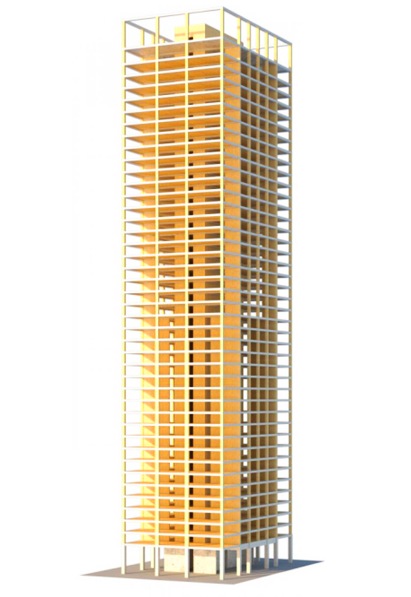In a report released today, Skidmore, Owings & Merrill discussed the results of the Timber Tower Research Project: an examination of whether a viable 400-ft, 42-story building could be created with timber framing. The prototype created by SOM incolves a combination of mass timber, concrete, and steel and was sponsored by the Softwood Lumber Board. Benchmarked against Chicago's DeWitt Chestnut Apartments—a concrete-framed facility considered revolutionary when SOM designed it in 1965—the Timber Tower represents a carbon-footprint reduction of 65% to 75%.
Tall buildings that embody conventional concrete and steel structural design usually have a higher carbon footprint than low-rise buildings, on a square-foot basis. SOM's experiment explores whether tall wood-framed buildings are feasible, justfying changes in contemporary building codes that generally limit the height of such buildings. "Building tall creates desirable urban density, but this solution helps us achieve this result with a much smaller carbon footprint," says SOM Structural and Civil Engineering Partner William F. Baker, PE, Se, FASCE, FIStructE.
SOM staff predict further developments, including possible building code adjustments, based on the research.
(http://archinect.com/news/article/74511379/som-releases-timber-tower-research-project)
Related Stories
| Nov 14, 2011
Griffin Electric completes electrical work at Cary Arts Center
The Griffin Electric team was responsible for replacing the previous electrical service on-site with a 1000A, 480/277V service and providing electrical feeds for a new fire pump chiller, six air-handlers and two elevators.
| Nov 14, 2011
303 East 33rd Street building achieves LEED-NC
The 165,000 sf 12-story residential building is the first green development to be LEED certified in the Murray Hill neighborhood of Manhattan.
| Nov 14, 2011
VanSumeren appointed to Traco general manager
VanSumeren will draw on his more than 20 years of experience in manufacturing management and engineering to deliver operational and service excellence and drive profitable growth for Traco.
| Nov 11, 2011
By the Numbers
What do ‘46.9,’ ‘886.2,’ and ‘171,271’ mean to you? Check here for the answer.
| Nov 11, 2011
Streamline Design-build with BIM
How construction manager Barton Malow utilized BIM and design-build to deliver a quick turnaround for Georgia Tech’s new practice facility.
| Nov 11, 2011
AIA: Engineered Brick + Masonry for Commercial Buildings
Earn 1.0 AIA/CES learning units by studying this article and successfully completing the online exam.
| Nov 11, 2011
How Your Firm Can Win Federal + Military Projects
The civilian and military branches of the federal government are looking for innovative, smart-thinking AEC firms to design and construct their capital projects. Our sources give you the inside story.
| Nov 10, 2011
BD+C's 28th Annual Reconstruction Awards
A total of 13 projects recognized as part of BD+C's 28th Annual Reconstruction Awards.
| Nov 10, 2011
Grousbeck Center for Students & Technology opens doors
New Perkins School for the Blind Building is dedicated to innovation, interaction, and independence for students.

















